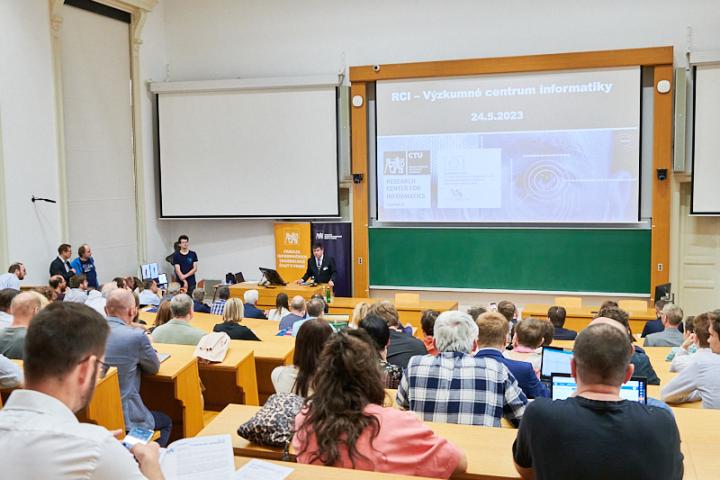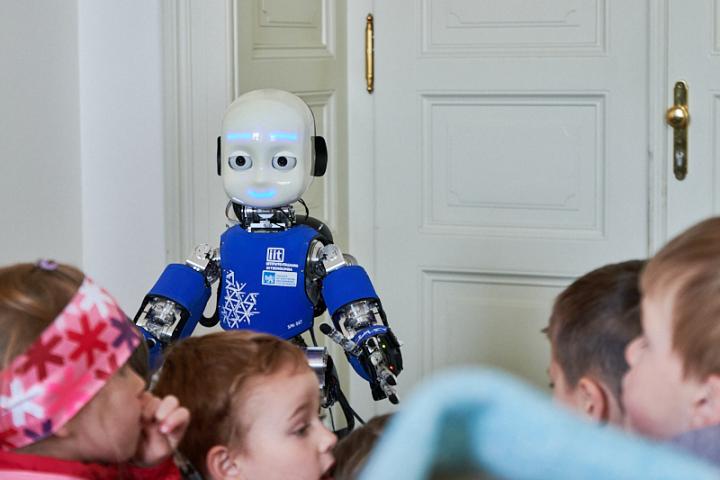
"RCI targets cutting-edge research. It addresses problems in artificial intelligence and computer science across a broad spectrum. From theoretical informatics to applications in medicine," said the head of the RCI project, Professor Jiří Matas from the Department of Cybernetics at the FEL CTU. He described that the project consisted of nine research packages focusing, for example, on computer vision, computer graphics, machine learning, cybersecurity and the use of machine learning in medicine. Professor Matas, who has long been involved in research on computer vision and target tracking using machine learning, pointed out that the RCI also enabled faculty teams to strengthen collaboration with top experts from around the world and invite them to their workplaces.
"RCI focuses on cutting-edge research. It deals with problems of artificial intelligence and computer science in a broad spectrum. From theoretical computer science to applications in medicine," said the head of the RCI project, Professor Jiří Matas from the Department of Cybernetics at FEL CTU. He described that the project consists of nine research packages focusing, for example, on computer vision, computer graphics, machine learning, cyber security and the use of machine learning in medicine. Professor Matas, who has long been involved in research on computer vision and target tracking using machine learning, stressed that the RCI has also enabled faculty teams to strengthen collaborations with top experts from around the world and invite them to their work sites.
One of the important benefits of the RCI project is the purchase of a computer cluster worth more than CZK 121 million, which ranks among the largest domestic supercomputers designed exclusively for non-commercial research purposes. "The cluster mainly runs frameworks for learning deep neural networks, such as PyTorch and TensorFlow," described Daniel Večerka from the Department of Cybernetics at FEL CTU. "Computation nodes, especially those with a GPU (graphics processing unit), are heavily used and most of the time there is some computation running on all 104 available GPUs," the expert added.
According to doc. Martin Saska, head of the Multirobotic Systems Group at the CTU Faculty of Engineering, the grant has helped to significantly expand the financially demanding research on cooperating formations and swarms of autonomous robots - drones. "Thanks to such a comprehensive project, which enabled direct cooperation with top scientific institutions, we were able to develop a globally unique multi-robot solution. In addition to dozens of scientific outputs, we have also managed to promote it in several industrial applications in cooperation with Czech companies," the scientist said. He explained that this is an innovative way of deploying groups of drones to detect trees infested with bark beetle, inspect industrial facilities or search for radiation sources. As a result, the department has won contracts with industry worth tens of millions of crowns and the companies involved are helping to fund further research.
Big data, security and theoretical computer science
"Faculty of Information Technology was responsible for research in the topics of powerful computing and big data, embedded security and theoretical computer science," said Professor Pavel Tvrdík, head of the Department of Computer Systems at the CTU FIT, whose team, in cooperation with researchers from the CTU FJFI, dealt with the area of powerful computing and big data. Within the project, his team developed a new library for programming supercomputers with GPUs, a software tool for processing big astronomical data, new methods for modelling exoplanet atmospheres, efficient algorithms for modelling atomic nuclei and more.
The research results of the Embedded Security Group were presented today by Professor Róbert Lórencz, Head of the Department of Information Security at FIT CTU. He emphasized the relevance of research in this area, which addresses both hardware security and reliability and deals with the issue of vulnerability of hardware components and their protection. "Secure production and safe use of chips with their reliable identification is nowadays a fundamental requirement in the design of secure computer systems that affect almost all areas of government, industry, as well as everyday life in the form of the Internet of Things, smart systems, automotive, etc.," said Professor Lórencz.
Research in the field of theoretical computer science was carried out by a group led by Professor Jan Holub. "Within the RCI project, we have been working on a range of theoretical problems such as creating compressed indexes for big biological data, processing tree data structures or assigning objects to agents according to their preferences, which is used, for example, in so-called food banks. In cooperation with the Technical University of Berlin, a program has been developed to ensure distribution in these banks," added Professor Holub from the Department of Theoretical Computer Science at Faculty of Informatics. Thanks to support from the RCI project, FIT CTU has acquired unique laboratory equipment, such as a Faraday cage or an experimental HPC cluster.
Technologies that can save lives
The humanoid robotics group of the FEL CTU has also gained an important reinforcement. "The main benefit for us is the acquisition of the humanoid robot iCub," said doc. Matěj Hoffmann, head of the group. The robot, which was also on display at today's event, has a number of unique features. "First and foremost, however, is that it has sensitive skin all over its body. It is central to my group's research in developmental robotics - the study of child and brain development using models in humanoid robots. It improves the possibilities for international collaboration through the possibility of sharing code, there are about 50 examples around the world, and increases the scientific importance and attractiveness of our department," summarised doc. Hoffmann.
During today's lecture series, for example, Dr. Radek Janča from the Department of Circuit Theory at FELU spoke about the results of research to help patients with the most severe form of epilepsy resistant to standard treatment. The condition of these people can be improved by surgically removing the areas in the brain responsible for seizures. The challenging procedure is preceded by a series of investigations, including mapping the epileptic network using intracranial electrodes, and the RCI research was specifically concerned with evaluating extremely complex data, which requires computer analysis and machine learning. Experts say the results of the current research will enhance the ability to diagnose and plan surgical approaches to epilepsy treatment and reduce the risk of post-operative complications.
Applications in medicine include research into artificial intelligence algorithms that can help speed up the development of anti-cancer drugs. The results of the project were first presented to the public a few weeks ago. The research, also supported by the RCI, was carried out by the teams of Professor Jan Kybic from the Department of Cybernetics at Faculty of Electircal Engineering and doc. Marian Hajdúch from Faculty of Medicine at Palacký University in Olomouc.
Autonomous robots capable of effective cooperation in searching difficult to access and dangerous places can help save human lives.Their research at FEL is led by professors Tomáš Svoboda, head of the Department of Cybernetics at FEL CTU, and Jan Faigl, head of the Laboratory of Computational Robotics. The focus today was, among other things, on the success of FEL roboticists in the American DARPA Subterranean Challenge, in which autonomous robots search for objects in underground spaces. This research was also supported by the RCI project.
In addition to the above-mentioned technologies, today people could see, for example, an advanced trolley for detailed scanning of surface appearance, a tactile 3D map that will help people with visual impairments with orientation in space, or the results of research by the team of Professor Daniel Sýkora from the Department of Computer Graphics and Interaction at FEL CTU.
Professor Sýkora said that with support from the RCI, his team, in collaboration with Google, has developed the Monster Mash system, which allows even laymen to create and animate 3D models using hand-drawn sketches. "Thanks to its accessibility and ease of use, the system is currently widely used in 3D animation education in primary, secondary and art schools in Europe and the US," the expert stressed. Another key topic, he said, was the issue of styling video using artwork. "In cooperation with Adobe and Snap, we have gradually developed several new approaches that allow us to change the visual form of the input video sequence according to the artist's ideas. The research has found wide application in the film industry and has been used, for example, to move the poster of Alfons Mucha within the iMucha project," the expert described.
The RCI project has also widely supported the mobility of male and female students involved in research. This includes Lukáš Rustler, currently a PhD student at the Department of Cybernetics. "As part of the RCI, I worked on a project modelling the shape of objects using a combination of visual sensors and robot touch. Thanks to the RCI, I was also able to travel to my first international conference in the US and to a three-month internship at the prestigious Imperial College London," Rustler described.
Although the RCI project is now formally over, according to Professor Jiří Matas, the research he supported is continuing. And thanks to him, we will probably see more interesting results in the future.



